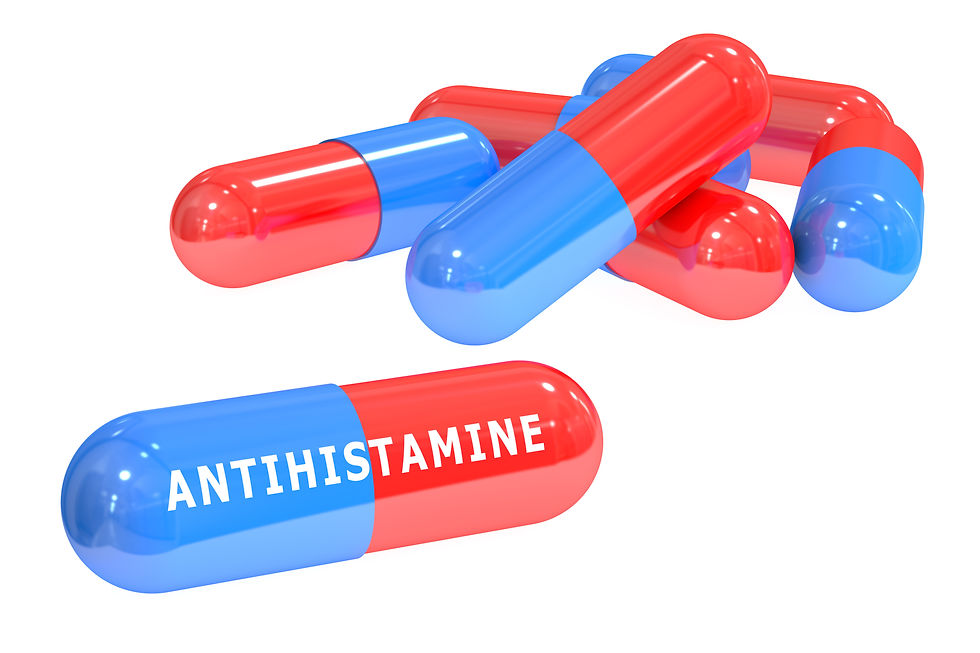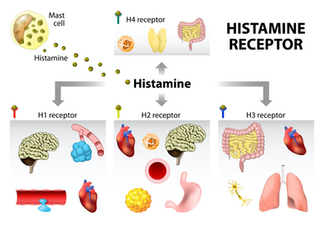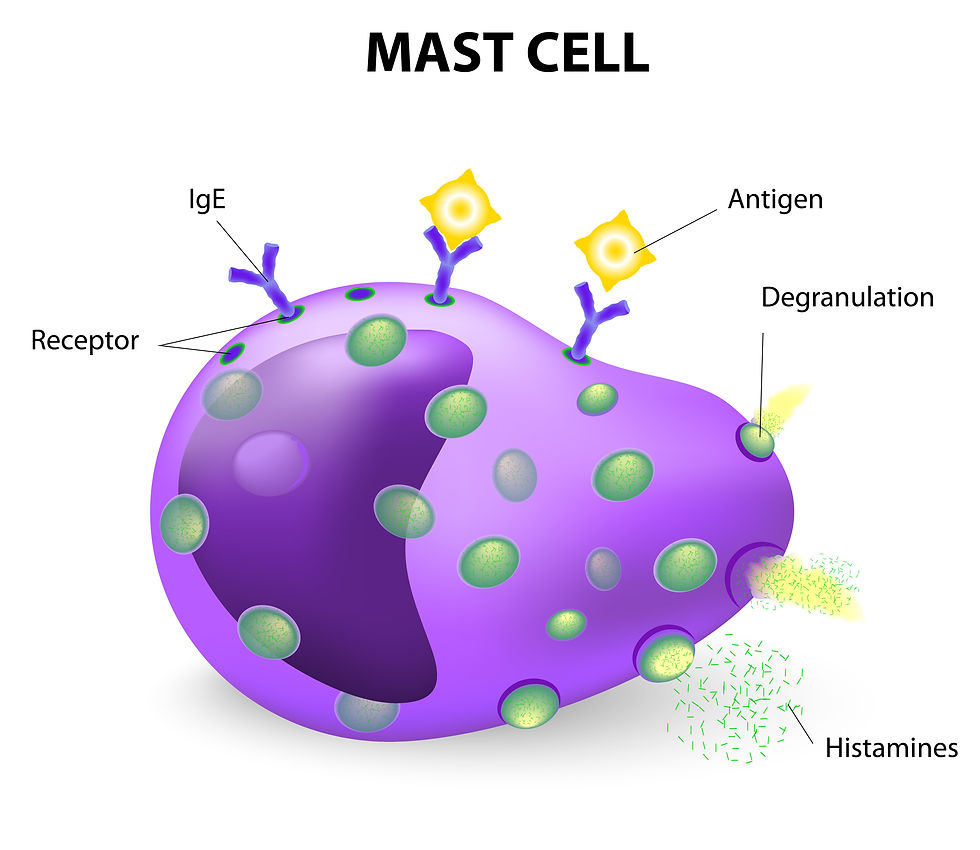Antihistamines in Dogs & Cats: When They Help, When They Don’t, and How We Use Them
- Dr Andrew Matole, BVetMed, MSc

- Aug 24
- 4 min read
What Are Histamines and Antihistamines?
Histamines are naturally occurring chemical messengers (biogenic amines) released primarily by mast cells and basophils in response to allergens, tissue injury, or immune activation. Once released, histamine binds to specific receptors (H1, H2, H3, and H4) throughout the body, where it triggers diverse effects such as itching, redness, swelling, increased stomach acid secretion, and smooth muscle contraction in the airways. In the skin and airways, the main receptor is H1(Church & Church, 2019).
Antihistamines are medications designed to block the action of histamine at its receptors, preventing or reducing these effects. In veterinary medicine, the most clinically relevant group is the H1 receptor antagonists, which help manage conditions like allergic skin disease, insect bite reactions, and motion sickness. By competitively binding to H1 receptors, these drugs blunt the impact of histamine on tissues, thereby reducing pruritus (itch), erythema (redness), and oedema (swelling) in companion animals.

They don’t remove the underlying allergy or switch off the entire inflammatory cascade — so their effect is often partial. (Merck Veterinary Manual, 2023). In practice, antihistamines are rarely curative but are valuable as part of multimodal therapy, especially for chronic allergic conditions where they can help lessen symptom severity, improve comfort, and sometimes reduce the need for stronger medications. Antihistamines are not strong anti-inflammatories and often aren’t enough for moderate–severe allergic skin disease by themselves (they’re usually part of a broader plan). (Miller et al., 2023; Merck Vet Manual).

Histamine pathway & H1 blockade
When do we reach for antihistamines?
In cases of acute allergic reactions (e.g., vaccine or insect-bite–associated hives/facial swelling), antihistamines are useful as part of emergency care to blunt histamine’s effects. (Merck Vet Manual). When combined with omega-3s, topical therapy, allergen control, and modern antipruritics, they can help some patients with mild pruritus, early atopic disease or flare prevention (AAHA 2023; Olivry et al., 2015). Certain H1 blockers, e.g., meclizine, dimenhydrinate, and diphenhydramine, can reduce nausea and drooling in cases of Motion sickness but timing matters (typically 30–60 minutes pre-travel).

When antihistamines are not enough, like in Moderate – severe allergic dermatitis cases, usually stronger, targeted anti-itch/anti-inflammatory therapy is needed, e.g., oclacitinib, lokivetmab, short steroid bursts, or cyclosporine, plus skin-barrier and infection control (AAHA 2023; Sauvé, 2023). Therefore, while antihistamines can help some dogs (especially with milder disease or for prevention), their effect on canine allergic pruritus is often modest and best results are achieved when they’re integrated into a multimodal plan tailored to the pet. (AAHA 2023; Olivry et al., 2015; Sauvé, 2023).
Choosing an antihistamine: first- vs second-generation
There are two generations of antihistamines, First-generation and Second-generation.
First-generation antihistamines (diphenhydramine, chlorpheniramine, hydroxyzine) cause more sedation and anticholinergic effects (dry mouth, urinary retention, tachycardia) and they should be used with caution in pets with glaucoma, urinary retention, significant heart disease, or geriatric patients. (Merck Vet Manual).
Second-generation antihistamines (cetirizine, fexofenadine, loratadine) generally they are less sedating at therapeutic doses because they’re less likely to cross the blood–brain barrier; still, overdoses can cause CNS/GI signs (Merck Vet Manual). Human “cold & allergy” combos containing decongestants (e.g., pseudoephedrine) or xylitol-sweetened syrups should never be used in pets as these can be dangerous (Merck Vet Manual).

Table 1: Examples of antihistamines that may be prescribed (with referenced dose ranges)
Important: Doses vary with diagnosis, patient factors, and product formulation. Do not medicate your pet without veterinary guidance.
Drug (class) | Dogs – example dose & interval | Cats – example dose & interval | Notes / Source |
Diphenhydramine (1st gen) | 2–4 mg/kgPO/IM/SC q8–12h | 1–2 mg/kgPO/IM/SC q8–12h(commonly 0.5–1 mg/kg) | Sedation common; motion-sickness utility. |
Chlorpheniramine (1st gen) | 0.25–0.5 mg/kg q8h (or 4 mg <20 kg; 8 mg >20 kg) | 2–4 mg/cat q12h | Often used in cats; may cause drowsiness. |
Hydroxyzine (1st gen) | 0.5–2 mg/kg q6–8h or 2 mg/kg q12h | 1–2 mg/kg q8–12h commonly used | Teratogenic; more sedating. |
Cetirizine (2nd gen) | 1 mg/kg (or 10–20 mg/dog) q12–24h | 5 mg/cat (≈1 mg/kg) q12–24h | Often least sedating; variable response. |
Fexofenadine (2nd gen) | 2–5 mg/kg q12–24h or 5–15 mg/kg q24h) | 10–15 mg/cat q12–24h | Avoid combo products with pseudoephedrine. |
Loratadine (2nd gen) | ~1 mg/kg q12h | (Limited feline use; consult) | Use plain loratadine only (no “-D” decongestant). |
Meclizine (1st gen; motion sickness) | 12.5–50 mg/dog q24h | 6.25–12.5 mg/cat q24h | Give 30–60 min before travel. |
Cyproheptadine (antihistamine/antiserotonergic) | 0.3–2 mg/kg q12h (dogs) | Commonly 1–4 mg/cat q12h; also used as appetite stimulant |

Dosing convenience (approximate doses/day in dogs)
How we use them at The Andys Veterinary Clinic
Diagnose properly first (rule out fleas/mites, infections; consider food trials and environment).
Match the drug to the job:
Sudden allergic hives, facial swelling → fast-acting H1 blocker ± other emergency meds.
Motion sickness → meclizine/dimenhydrinate/diphenhydramine at the right time pre-travel. (Merck Vet Manual; VIN).
Mild atopy/flare prevention → a second-generation option like cetirizine may be tried; we monitor response and adjust. (AAHA 2023).
Combine intelligently with other therapies when needed: Antihistamines + topical therapy, skin-barrier support, allergen avoidance, and—when needed—modern antipruritics (oclacitinib/lokivetmab) or short steroid tapers. (AAHA 2023).
Review safety before starting (comorbidities, drug interactions, product selection—no decongestants/xylitol). (Merck Vet Manual).
Frequently Asked Questions (FAQs)
Do antihistamines work for every itchy dog?
No. Some dogs respond, others don’t. If itch remains after a 7–14 day trial, we usually pivot to more targeted treatments. (AAHA 2023; Olivry et al., 2015).
Which is “best”: diphenhydramine or cetirizine?
It depends on the pet and the goal (e.g., sedation vs daytime comfort). We often prefer cetirizine for less drowsiness; diphenhydramine may help when some sedation is acceptable. (Merck Vet Manual).
Can I give my pet a human allergy tablet at home?
Not without guidance. Many human products contain extra ingredients that are unsafe for pets. Always check with us or your vet first. (Merck Vet Manual).
References
Church, M.K. & Church, D.S. (2019). Pharmacology of antihistamines. World Allergy Organization Journal.
Miller, J., Simpson, A., Bloom, P., et al. (2023). AAHA Management of Allergic Skin Diseases in Dogs and Cats Guidelines.American Animal Hospital Association. AAHA
Merck Veterinary Manual (2023). Antihistamines in Animals – Pharmacology; Clinical Use; Dosage Tables.
Olivry, T., et al. (2015). Treatment of canine atopic dermatitis: 2015 updated guidelines. BMC Veterinary Research. BioMed Central
Sauvé, F. (2023). Itch in dogs and cats (review). Canadian Veterinary Journal. PMC
For feline dosing examples: Today's Veterinary Practice—“Feline Dermatology: Cats Are Not Small Dogs.” Today’s Veterinary Practice
VIN/VeterinaryPartner meclizine client handout (timing for motion-sickness dosing). veterinarypartner.vin.com














Comments